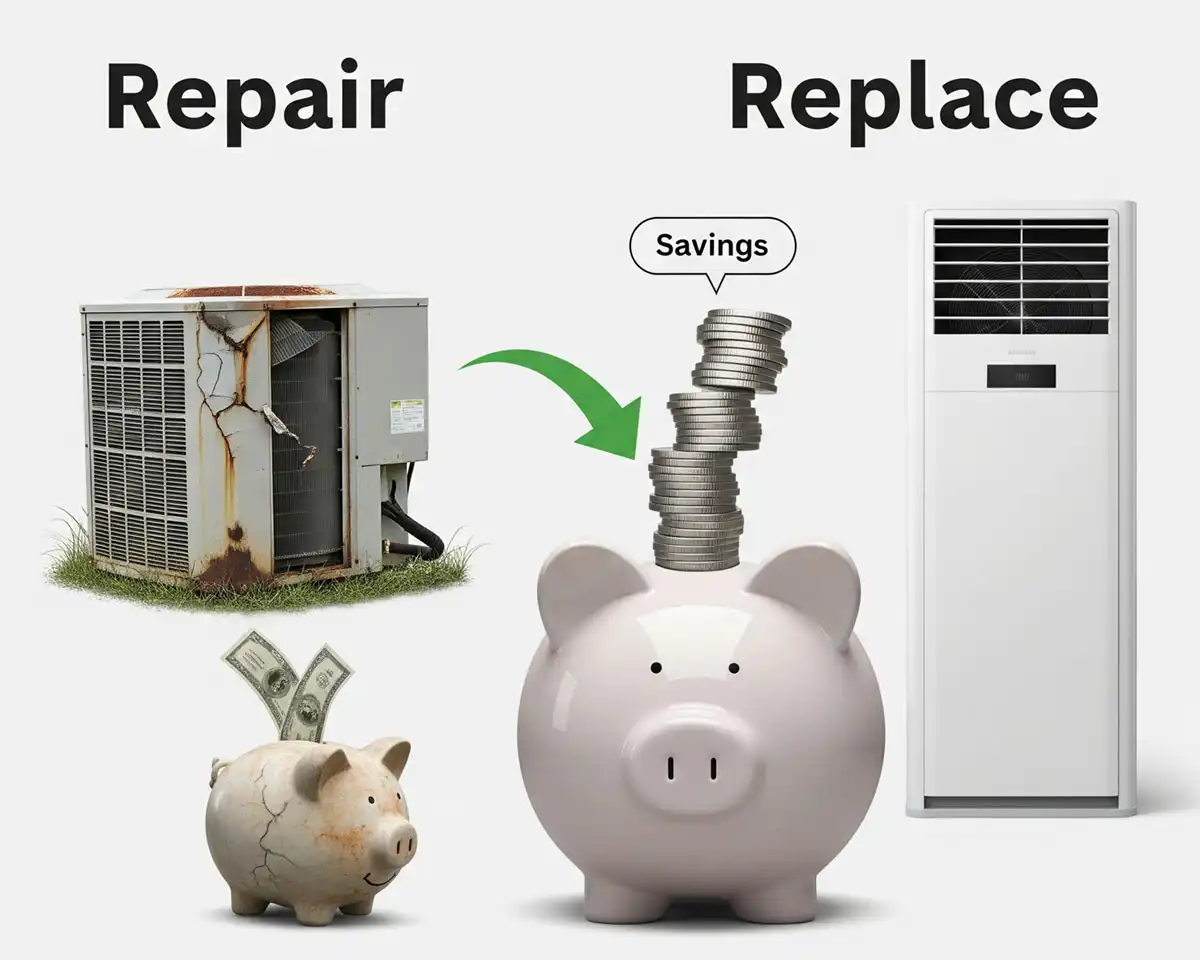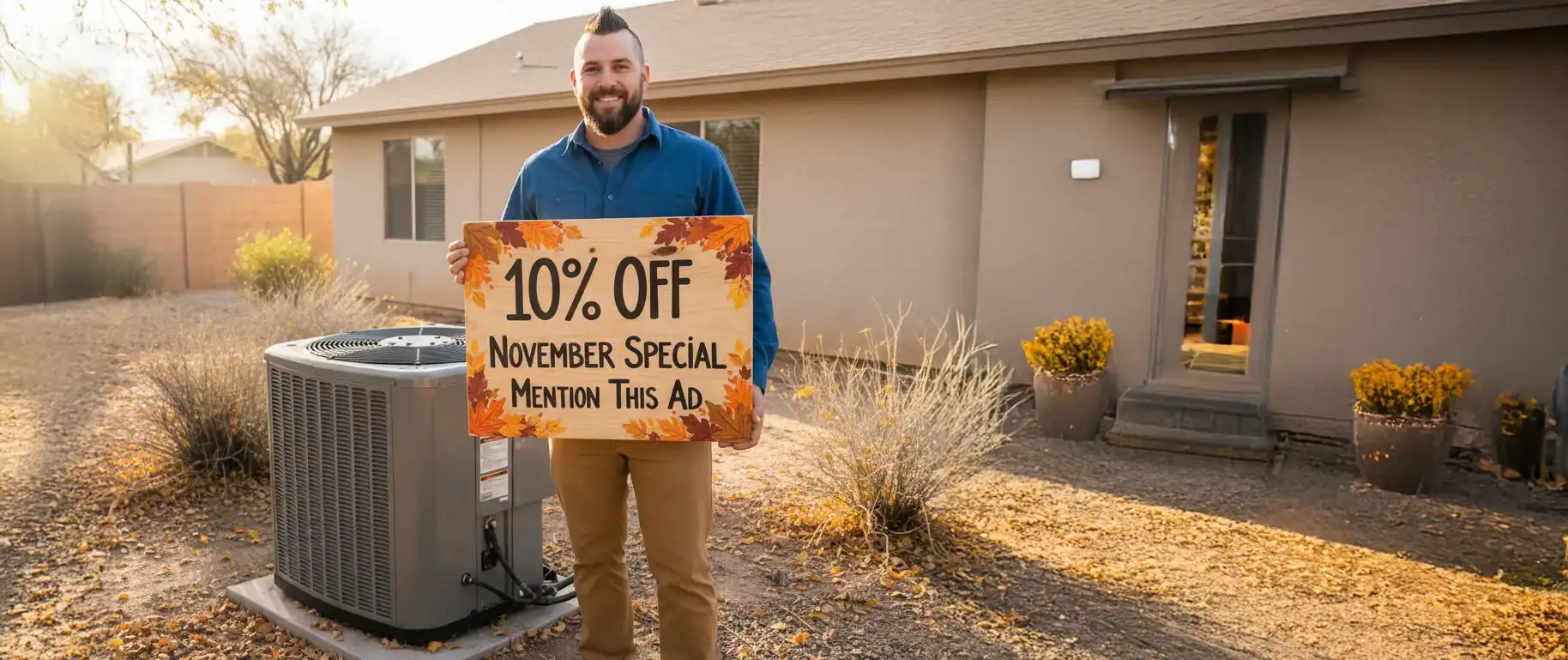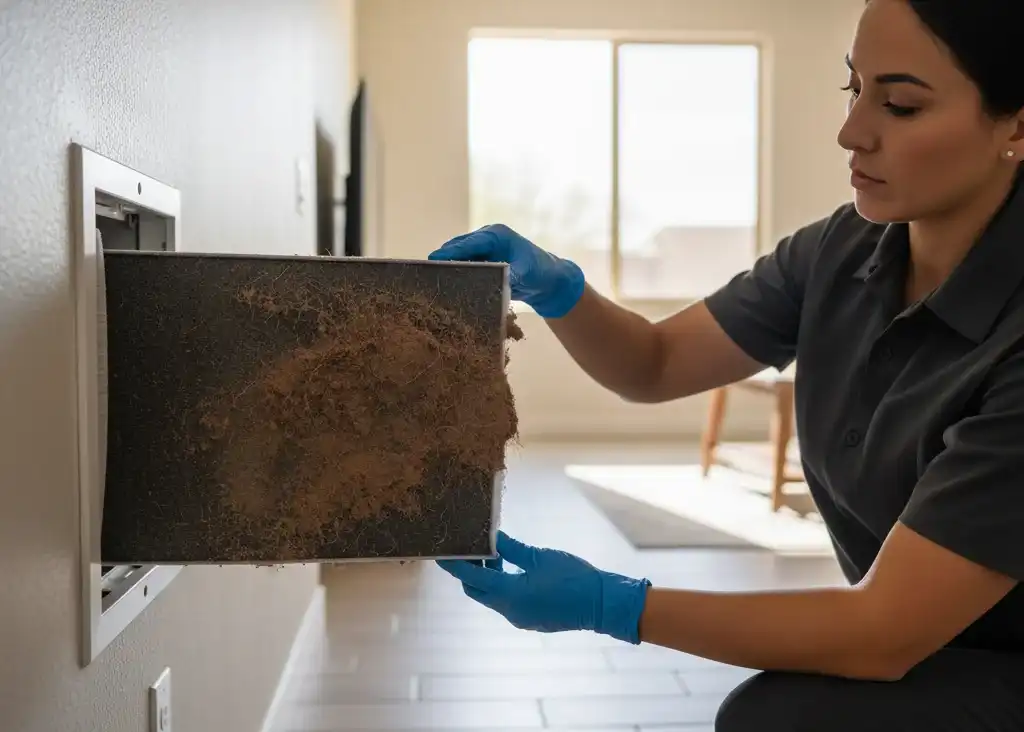
On a blistering 115-degree September afternoon on Arizona’s West Coast, the familiar hum of the air conditioning unit sputters and dies. For residents of Fort Mohave, Bullhead City, and the surrounding communities, this scenario is more than an inconvenience; it is an emergency. As the Mohave County Department of Public Health advises, reliable cooling is a matter of public health and safety in our extreme climate.
This situation forces a critical and often costly decision: repair an aging system or invest in a full replacement. This guide serves as a comprehensive, data-driven analysis for 2025, designed to empower homeowners by demystifying this decision with practical financial rules, an explanation of the new SEER2 energy standards, and a cost-benefit analysis tailored to our local market.
Table of Contents
- Why Our Climate Is Different: Your AC’s Lifespan in the Desert
- The Decision Toolkit: Simple Rules to Guide Your Choice
- Anatomy of a Repair Bill: Understanding AC Repair Costs
- Decoding SEER2: The New Standard for AC Efficiency
- The Investment of Replacement: A Full Cost & Benefit Analysis
- Navigating Local Regulations and Permits
- Conclusion: Making the Smartest Decision
Why Our Climate Is Different: Your AC’s Lifespan in the Desert
The operational environment in Mohave County is uniquely hostile to air conditioning systems. The convergence of extreme heat, pervasive dust, and low humidity creates a set of challenges that significantly shortens the expected service life of HVAC equipment.
The Climate’s Brutal Impact
Three primary environmental aggressors are at work: Extreme Heat, Pervasive Dust, and Low Humidity (Dry Air). This combination forces AC units to run almost continuously, clogs vital components, and causes materials like rubber seals and wiring insulation to become brittle and crack.
AC Lifespan Comparison
Units in our area work harder and fail sooner. While the national average suggests a 15-20 year lifespan, the reality in our climate is much different, often only 10-14 years.
Extreme Heat Stress
Near-continuous operation for 8+ months puts unrelenting strain on the compressor, leading to premature failure.
Pervasive Desert Dust
Fine dust clogs filters and coats condenser coils, severely reducing efficiency and causing the system to overheat.
Corrosive Dry Air
Arid conditions cause rubber seals and electrical insulation to become brittle and crack, leading to costly leaks.
The Decision Toolkit: Simple Rules to Guide Your Choice
To navigate the repair-or-replace dilemma, homeowners can use several industry-standard rules of thumb, interpreted through the lens of our shortened equipment lifespan.
- The ‘$5,000 Rule’: Multiply the unit’s age by the repair cost. If it’s over $5,000, replacement is recommended.
- The ‘50% Rule’: If a repair costs 50% or more than a new system, replacement is the clear choice.
- The Age & Frequency Factor: A unit over 12 years old or one needing frequent repairs is a strong candidate for replacement.
| Factor | Leans Toward REPAIR | Leans Toward REPLACE |
|---|---|---|
| Age of Unit | Less than 8 years | Over 12 years (8-12 is neutral) |
| Repair Cost (vs. New Unit) | Less than 30% of replacement cost | More than 50% of replacement cost |
| $5,000 Rule Score | Well below $5,000 | Over $5,000 |
| Repair Frequency | First major repair in years | Multiple repairs in the last 2 years |
| Energy Bills | Stable / Predictable | Steadily increasing |
| Refrigerant Type | Uses modern R-410A | Uses phased-out R-22 |
The Anatomy of a Repair Bill: Understanding AC Repair Costs
Understanding potential repair costs is essential. While minor electrical fixes are manageable, any issue with the sealed refrigerant system—like leaks or compressor failure—pushes the cost into a range where replacement becomes a more viable long-term option.
Common AC Repair Costs in Our Area (2025)
Decoding SEER2: The New Standard for AC Efficiency
A critical factor weighing on the replacement side is the new federal standard for energy efficiency. SEER2 (Seasonal Energy Efficiency Ratio 2) is the updated U.S. Department of Energy metric for measuring cooling efficiency, which went into effect on January 1, 2023. It uses more realistic testing conditions to better reflect real-world performance.
For any new system installed in Arizona, the minimum efficiency is now 14.3 SEER2. This means even the most basic new unit is significantly more efficient than older models, guaranteeing energy savings.
The Investment of Replacement: A Full Cost & Benefit Analysis
Choosing to replace an AC unit is a significant capital investment, but one that offers substantial long-term financial returns. Homeowners in our area should investigate rebates and programs from their local utility provider, such as UniSource Energy Services or Mohave Electric Cooperative. Additionally, all Arizona residents may be eligible for programs like the APS Smart Thermostat Rebate.
| Efficiency Tier | SEER2 Rating Range | Estimated Cost Range |
|---|---|---|
| Standard Efficiency | 14.3 – 15.2 SEER2 | $7,000 – $12,000 |
| High Efficiency | 16.0 – 18.0 SEER2 | $11,000 – $18,000 |
| Premium/Variable-Speed | 19.0+ SEER2 | $16,000 – $26,000+ |
Navigating Local Regulations and Permits
A full AC system replacement is a major home renovation that requires adherence to local building codes. Proper permits ensure the installation is safe, efficient, and up to standard. Information on requirements can typically be found through the Mohave County Development Services or, for residents within city limits, the Bullhead City official website. A reputable contractor will handle the entire permitting process for you.
Ready for a Professional Opinion?
The final, essential step is to contact a licensed, qualified HVAC professional to obtain accurate quotes for both repair and replacement. This provides the concrete data needed to make a confident choice for your home.
Get a Free EstimateConclusion: Making the Smartest Decision for Your Home
The decision to repair or replace an air conditioner in our region is a complex calculation of age, cost, and long-term value. The following steps provide a logical framework for making an informed choice.
- Assess Your Unit’s Age: If it’s over 10 years old, it’s in the high-risk category.
- Get a Repair Quote: Obtain a firm, written estimate from a licensed technician.
- Apply the Rules: Use the ‘$5,000 Rule’ and ‘50% Rule’ to evaluate the repair.
- Get Replacement Quotes: Secure quotes for both baseline and high-efficiency new systems.
- Factor in Incentives: Research federal tax credits and local utility rebates.
- Compare Net Costs: Analyze the one-time repair cost against the net cost of a replacement.
Frequently Asked Questions
How long do AC units last in the Fort Mohave area?
Due to the extreme climate, AC units in our region have a shorter lifespan than the national average, typically lasting 10 to 14 years.
What is SEER2 and why does it matter?
SEER2 is a stricter, more realistic energy efficiency standard effective since 2023. It ensures that all new AC units in Arizona meet a higher minimum efficiency (14.3 SEER2), guaranteeing better performance and lower energy bills compared to older systems.
Is it worth repairing an AC unit that uses R-22 refrigerant?
Generally, no. R-22 refrigerant is being phased out, making it extremely expensive and difficult to obtain. If your system requires a major R-22 related repair, it is almost always more cost-effective to replace the entire system.





